Ulster Overcoat
-
Guest
Gents,
I'm interested in the possibility of having an Ulster made. My natural inclination is for a Chesterfield or a Covert, but the more I see the Ulster, the more I am intrigued by it. Are there any "rules" which one must adhere to re. length, cuff treatment (e.g. turnback vs. plain), buttoning and so on? Any relevant links or advice would be appreciated.
Spinola
I'm interested in the possibility of having an Ulster made. My natural inclination is for a Chesterfield or a Covert, but the more I see the Ulster, the more I am intrigued by it. Are there any "rules" which one must adhere to re. length, cuff treatment (e.g. turnback vs. plain), buttoning and so on? Any relevant links or advice would be appreciated.
Spinola
-
Guest
The revival of this thread seems appropriate as I have similar thoughts, though I don't know if the original poster is still with this forum. My situation is this: I would like a formal overcoat for formal and semi-formal evening dress. In order to extend its usefulness (and my investment) I'd like to be able to use it with a sharp suit as well. I don't know if this would be possible, but here are my thoughts.
Formal/semi-formal Evening:
6x2 DB ulster, beltless, fitted (not the large voluminous ulsters) with removable cape (between elbow and hand length). I know the actual definition of an Ulster may still be debated, but that is not the purpose of this thread. I'd like this classy look (like an inverness with sleeves).
Tradition calls for a black material. This seems too formal for daywear with a suit (sans cape, of course). Would you agree or disagree?
Extending its usefulness:
In order to avoid its relegation strictly to formal/semi-formal evening dress, I have some thoughts on colors that I wondered if they would do as I wish without giving up the formal evening arena. Understanding what compromise entails, can any of these or other suggestions work to keep it well within the bounds of both formal evening and smart day wear (such as DB navy or charcoal worsted suit, etc.). The removable cape already helps. Other ideas:
charcoal or oxford grey color
Navy (such as the paddock overcoat referred to often by Etutee and others)
Fine herringbone with black and charcoal or two greys
grey or black lining?
Am I just lost in wishful thinking, or can this be done gracefully? Thank you for your thoughts.
pbc
Formal/semi-formal Evening:
6x2 DB ulster, beltless, fitted (not the large voluminous ulsters) with removable cape (between elbow and hand length). I know the actual definition of an Ulster may still be debated, but that is not the purpose of this thread. I'd like this classy look (like an inverness with sleeves).
Tradition calls for a black material. This seems too formal for daywear with a suit (sans cape, of course). Would you agree or disagree?
Extending its usefulness:
In order to avoid its relegation strictly to formal/semi-formal evening dress, I have some thoughts on colors that I wondered if they would do as I wish without giving up the formal evening arena. Understanding what compromise entails, can any of these or other suggestions work to keep it well within the bounds of both formal evening and smart day wear (such as DB navy or charcoal worsted suit, etc.). The removable cape already helps. Other ideas:
charcoal or oxford grey color
Navy (such as the paddock overcoat referred to often by Etutee and others)
Fine herringbone with black and charcoal or two greys
grey or black lining?
Am I just lost in wishful thinking, or can this be done gracefully? Thank you for your thoughts.
pbc
-
Guest
The coat would be similar in form to that posted by Alden in another thread (but with a removable cape added).
alden wrote:As regards other Formal overcoats that have been revived over recent years, one would include the "Ulster" model, a patelot variant. The following is a version by Caraceni.
NB: This is not an ad for M Caraceni, the details of his Sartoria happen to be on the photo. I expect Maestro Caraceni does not need much publicity these days.
-
Guest
If you really intend it to be formal, not just semi-formal, then it has to be black. No question. The problem is that the design of an Ulster is more rugged than an elegant evening coat like an Inverness, which is more different than just the sleeves (as far as I can tell from the old plates).
You are probably already thinking of these already in fact, but I'll put up the plates anyway:
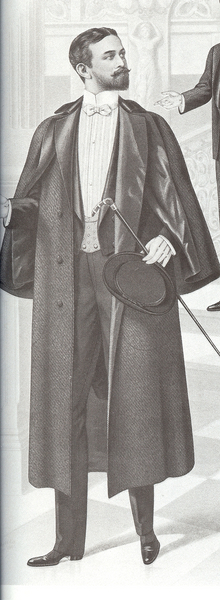


If you look at his hat in the last plate, it would seem that the Ulster is much more of a working coat, with heavy twill fabric.
I, too, love the idea of old coats like these, but I doubt any combination of the two would quite meet the standards of some (...) here.
If you want a proper formal coat, Inverness style, it will not go with a suit. On the other hand, a Chesterfield/Paletot in finer fabric (like in Mr Alden's photograph) could go well with white tie with an added cape. In fact, strangely enough it seems that the looser coat (Chesterfield) might be a better fit with white tie, as both formal coats above are hanging very freely with no seams at all.
NCW
You are probably already thinking of these already in fact, but I'll put up the plates anyway:



If you look at his hat in the last plate, it would seem that the Ulster is much more of a working coat, with heavy twill fabric.
I, too, love the idea of old coats like these, but I doubt any combination of the two would quite meet the standards of some (...) here.
If you want a proper formal coat, Inverness style, it will not go with a suit. On the other hand, a Chesterfield/Paletot in finer fabric (like in Mr Alden's photograph) could go well with white tie with an added cape. In fact, strangely enough it seems that the looser coat (Chesterfield) might be a better fit with white tie, as both formal coats above are hanging very freely with no seams at all.
NCW
-
Guest
PS. I put those images up on Wikimedia Commons under Category:History_of_clothing (some other stuff is in there too). Whenever anyone else here scans any old photos or spots them lying around, it might be useful to put them up there too. I stress old, because AA illustrations will get you banned from Wiki.
-
Guest
NCW wrote:If you really intend it to be formal, not just semi-formal, then it has to be black. No question.
But the Paddock coat option for formal dress is to be navy. I believe I have read in a few places that a navy overcoat is acceptable for full evening dress. This is mentioned in this post:
http://thelondonlounge.net/gl/forum/vie ... php?t=4918 Opinions indicated that the chesterfield (if I were to go that route with the removable cape) is appropriate for both suits and white tie. At least one person felt charcoal or black would be correct for evening full dress also. Here, Alden also quotes Emily Post saying
Regarding the cape option as with an inverness, ulster, or opera cloak, and mixing it with the more modern chesterfield:Emily Post 1922 wrote:"Have your overcoat of plain black or dark blue material, for you must wear an overcoat with full dress even in summer. "
Agreed. My appeal was to get opinions on whether this was possible and what it would take to still be acceptable to both.NCW wrote:I, too, love the idea of old coats like these, but I doubt any combination of the two would quite meet the standards of some (...) here.
Excellent point. The Chesterfield does appear to be what I am looking for in terms of the actual coat style. The explanation of the looser coat is also well said. I refer to Alden's same post wherein he saysNCW wrote: ... a Chesterfield/Paletot in finer fabric (like in Mr Alden's photograph) could go well with white tie with an added cape. In fact, strangely enough it seems that the looser coat (Chesterfield) might be a better fit with white tie, as both formal coats above are hanging very freely with no seams at all.
With this information, I can adjust the questions to be:Alden wrote:Take a look at films from the 1930s and you will see the black SB coats often assorted with capes. The cape is probably the last remaining vestige of formal outerwear that exists today. "
1. Is a charcoal or navy chesterfield appropriate for evening full dress? (Do you agree with the references given?) Black would most certainly be infallible.
2. Would the addition of a cape be undesirable with a chesterfield?
3. Can a black chesterfield be worn with a suit or is it out of place?
Thank you kindly for your inspiration.
pbc
-
Guest
My thoughts:
RWS
Dark charcoal might be -- certainly would be in most circles today, but probably wouldn't be in the most conservative. Midnight blue, darker than navy, is now probably universally acceptable.pbc wrote:. . . . 1. Is a charcoal or navy chesterfield appropriate for evening full dress? (Do you agree with the references given?) Black would most certainly be infallible.
I think so.2. Would the addition of a cape be undesirable with a chesterfield?
It appears a bit too dressy to me, but I see it frequently.3. Can a black chesterfield be worn with a suit or is it out of place? . . . .
RWS
-
Guest
The Ulster is a sporty overcoat, not adequate for evening dress, in my view, or for formal cloth/colours. You could opt for a dark blue Guards Coat, with more military lines, often depicted in old illustrations with full evening dress (also wearable over a city suit, I think).
Personally I would choose a black SB Chesterfield for evening wear.
Costi
Personally I would choose a black SB Chesterfield for evening wear.
Costi
-
Guest
Sorry, that is quite right; I was thinking 'Inverness' when I said 'it. Chesterfields/Guards coats come in navy, but a real Inverness is surely black only.Anonymous wrote:NCW wrote:If you really intend it to be formal, not just semi-formal, then it has to be black. No question.
But the Paddock coat option for formal dress is to be navy.
Black is probably only worth going for with the cape option (in my inexperienced opinion). I am sure there is someone here who could pull it off though, remembering that one of the criteria seemed to be that the coat should double up for daytime as well. RWS' idea of midnight blue is a very good one, I think, as it would work for day and night; plain navy is good for black tie, but perhaps not so good for white tie. (I am slowly putting together my first white tie outfit at the moment actually, so I may well look out for a navy Chesterfield now myself.)1. Is a charcoal or navy chesterfield appropriate for evening full dress? (Do you agree with the references given?) Black would most certainly be infallible.
That is the key question. Since for both of us I suspect the full Inverness is far too much, any cape would have to be added. Perhaps someone more knowledgeable has seen this before. In fact, this is just where some of Sator's patterns might be useful.2. Would the addition of a cape be undesirable with a chesterfield?
Finally, addressing Costi, why did you specify single breasted? Even the Ulster came in double breasted, which is surely a more appropriate cut (although the Guard's coat, which you say was wearable with white tie, is single...).
NCW
-
Guest
NCW, I recommended a SB fly front Chesterfield for full evening dress because, in my opinion, it is more formal than the DB version.
Costi
Costi
-
Guest
My mistake. I had the picture in front of me of the man, back to artist, helping the lady out of the car. I did not notice it was double, and my memory deceived me. The description says it, as does the peak here:

NCW

NCW
-
Guest
An Ulster is a garment that has undergone much change.
Originally, it had a hood or a cape.

It has subsequently lost these, but retains patch pockets and a belted back. It works best when it has lapel that is angle downwards somewhat like this:

I am fascinated by the Italian use of the French term paletot in connection with the Ulster overcoat.
An Inverness can be a formal evening overcoat in a solid dark colour or a travelling coat, usually in a check pattern or tweed. It has NO cape. It has wings but NOT a full cape extending all the around the back, as clearly shown on this fashion plate:
[I
A day wear version of the Inverness:
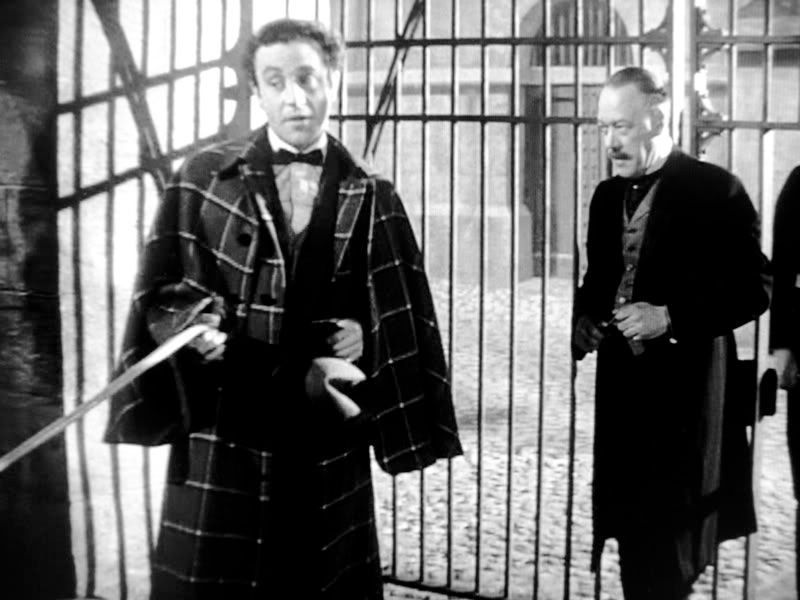
This is a paddock coat is a casual/sports overcoat as the name 'paddock' implies:

It is basically a paletot without a side body.
This, on the other hand, is a frock overcoat aka a top frock:

A close up reveals that this is a type of body coat with a waist seam. A paddock coat simply does not have a waist seam, and it is absurd to refer to such a formal day wear overcoat as a 'paddock coat'.


Originally, it had a hood or a cape.

It has subsequently lost these, but retains patch pockets and a belted back. It works best when it has lapel that is angle downwards somewhat like this:

I am fascinated by the Italian use of the French term paletot in connection with the Ulster overcoat.
An Inverness can be a formal evening overcoat in a solid dark colour or a travelling coat, usually in a check pattern or tweed. It has NO cape. It has wings but NOT a full cape extending all the around the back, as clearly shown on this fashion plate:
[I

A day wear version of the Inverness:

This is a paddock coat is a casual/sports overcoat as the name 'paddock' implies:

It is basically a paletot without a side body.
This, on the other hand, is a frock overcoat aka a top frock:

A close up reveals that this is a type of body coat with a waist seam. A paddock coat simply does not have a waist seam, and it is absurd to refer to such a formal day wear overcoat as a 'paddock coat'.


-
Guest
In addition to my above post, which I forgot to sign, I neglected to add that an Ulster should not be too waisted. It is a casual sports coat after all.
For dressier occasions, the Chesterfield is the standard modern overcoat for day and evening dress, formal and informal wear. It may be a little more waisted according to taste.
Only the top frock was ever strongly waisted as shown in the above illustration.
Here also is a common construction method for the vent of a frock overcoat:
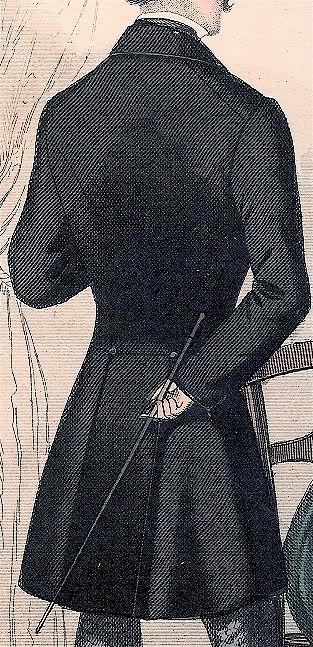
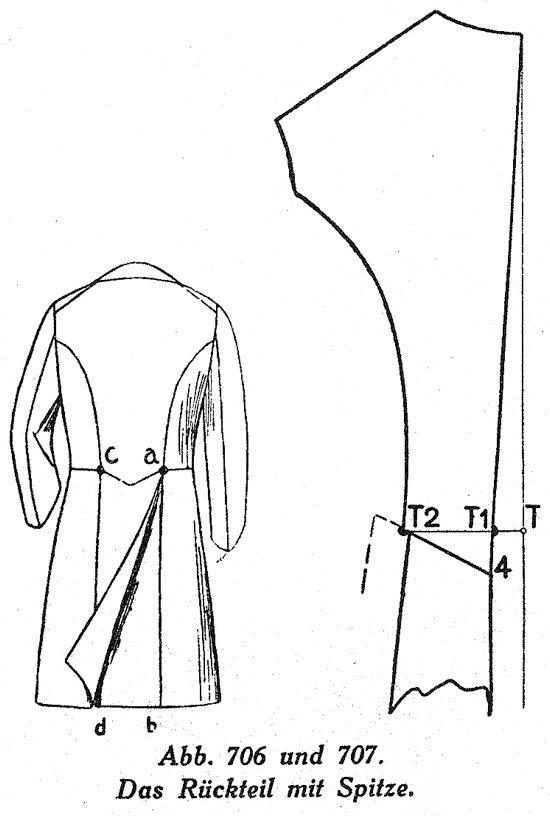
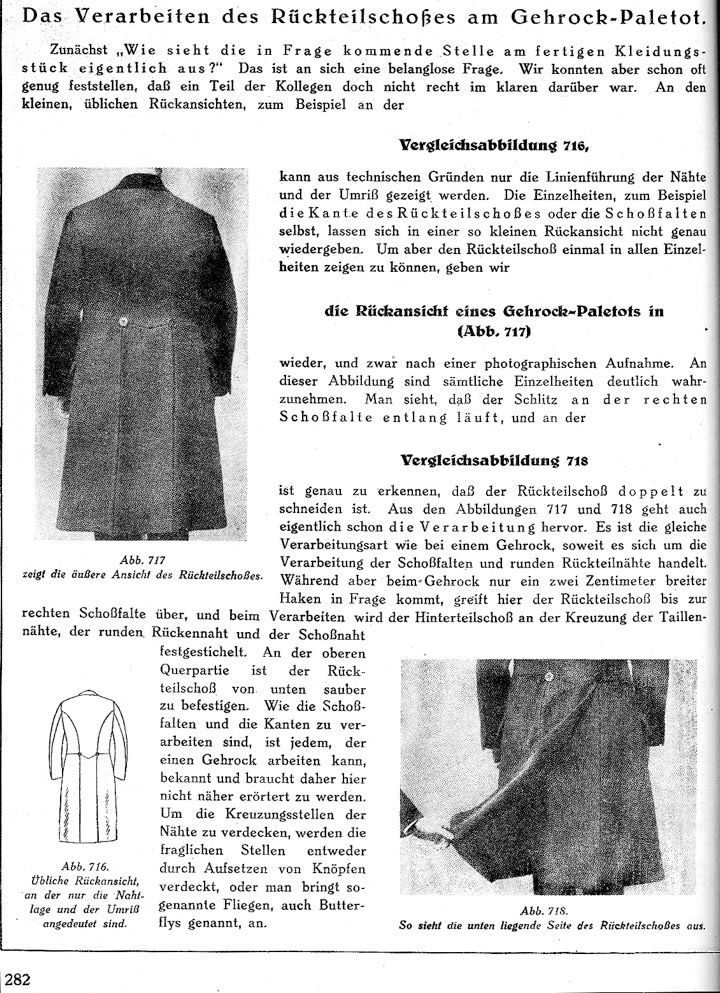
Sator
SATOR
AREPO
TENET
OPERA
ROTAS
For dressier occasions, the Chesterfield is the standard modern overcoat for day and evening dress, formal and informal wear. It may be a little more waisted according to taste.
Only the top frock was ever strongly waisted as shown in the above illustration.
Here also is a common construction method for the vent of a frock overcoat:



Sator
SATOR
AREPO
TENET
OPERA
ROTAS
-
Guest
Thank you, Sator. I believe I did read of the Ulster being in different materials, colors, and cuts that would allow for formal wear as well, though I may be confusing it with the inverness. So it would appear that the actual name of what I am considering has changed from an Ulster to an Inverness to a Chesterfield to a Paddock to a Frock, bringing me right back to the beginning of standard formal outerwear. Interesting.
Would a cape work on any waisted overcoat? Or would the free flow of a cape clash with the fitted form of a waisted garment? I do like that frock coat (where you showed the close up of the waist seam). Would that be navy or midnight blue? Would midnight blue serve my purposes? It would seem a frock overcoat in black, navy, or midnight blue would still seem too formal for a suit (even a very "dressy" suit). Would you agree, or can it be done?
Thanks.
pbc
Would a cape work on any waisted overcoat? Or would the free flow of a cape clash with the fitted form of a waisted garment? I do like that frock coat (where you showed the close up of the waist seam). Would that be navy or midnight blue? Would midnight blue serve my purposes? It would seem a frock overcoat in black, navy, or midnight blue would still seem too formal for a suit (even a very "dressy" suit). Would you agree, or can it be done?
Thanks.
pbc
-
- Information
-
Who is online
Users browsing this forum: No registered users and 3 guests

